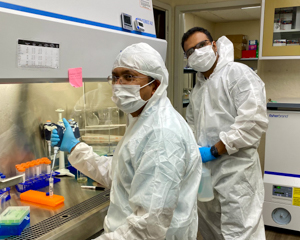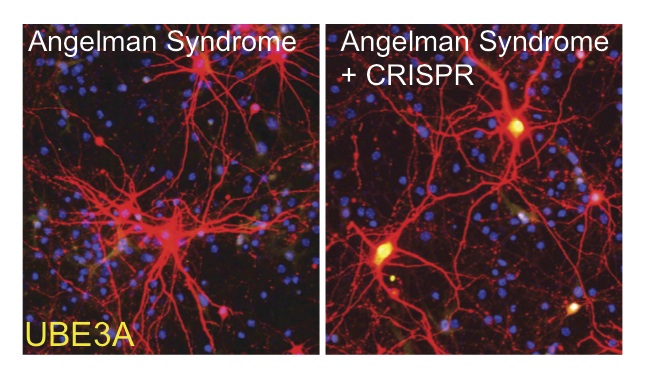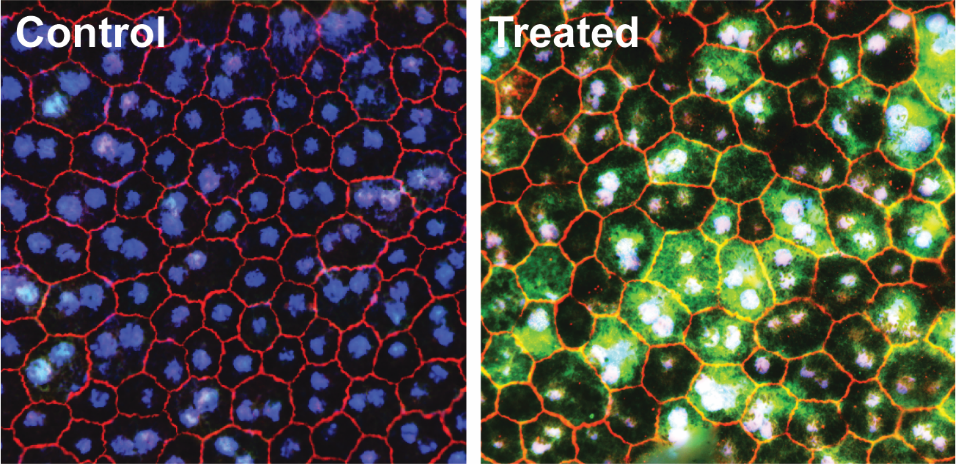Gene therapy as treatment for MS
Tag: Gene Therapy
A novel finding on Kabuki syndrome, a rare genetic disease
An Italian team has recreated for the first time the pathological condition in a test tube discovering what happens in the cell nucleus and what hinders the formation of cartilages and bones
Technique to regenerate optic nerve offers hope for future glaucoma treatment
Scientists have used gene therapy to regenerate damaged nerve fibres in the eye, in a discovery that could aid the development of new treatments for glaucoma, one of the leading causes of blindness worldwide. Axons – nerve fibres – in…
New insights on a common protein could lead to novel cancer treatments
A new University of Colorado Boulder-led study sheds light on a protein key to controlling how cells grow, proliferate and function and long implicated in tumor development. The findings, published this week in the journal Genes and Development , could…
Expensive gene therapies raise challenges and opportunities: Expert panel report
New CCA expert panel report
SMART researchers develop new gelatin microcarrier for cell production
Gelatin-based microcarriers offer higher yield and scalability compared to existing commercial microcarriers
Study identifies pitfall for correcting mutations in human embryos with CRISPR
In a paper published today in the journal Cell , scientists describe unexpected, undesirable outcomes after editing genes in human embryos with CRISPR, a genomic editing system. The study, the most detailed analysis to date of CRISPR in human embryos,…
Cancer’s dangerous renovations to our chromosomes revealed
Cancer remodels the architecture of our chromosomes so the disease can take hold and spread, researchers at the University of Virginia have revealed. This remodeling is important because the arrangement of the components in our chromosomes actually affects the workings…
Yeast study yields insights into longstanding evolution debate
In the past two decades, researchers have shown that biological traits in both species and individual cells can be shaped by the environment and inherited even without gene mutations, an outcome that contradicts one of the classical interpretations of Darwinian…
New COVID-19 related genes — helpful and harmful — found in massive screen
Researchers at Yale University and the Broad Institute of MIT and Harvard screened hundreds of millions of cells exposed to the COVID-19 and MERS viruses and identified dozens of genes that both enable the viruses to replicate in cells and…
CRISPR screen identifies genes, drug targets to protect against SARS-CoV-2 infection
NEW YORK, NY (October 26, 2020) – To identify new potential therapeutic targets for SARS-CoV-2, a team of scientists at the New York Genome Center, New York University, and the Icahn School of Medicine at Mount Sinai, performed a genome-scale,…
New genes related to autism spectrum disorder
Transposon domestication in the BEX/TCEAL cluster and autism
Scientists develop genetic ‘monitors’ that detect when genes are active
New genetic sensors, developed by scientists at University of Warwick and Keele University, could function as a lab test device and even as a live monitoring system inside living cells The innovative system can detect when a specific gene in…
Researchers solve ‘protein paradox’ and suggest way to exploit cancer weakness
Every cell in our body constantly divides to form new cells. This happens without us even thinking about it. However, every single time a cell divides, a complicated process has to unfold just the right way for our cells to…

Scientists use gene therapy and a novel light-sensing protein to restore vision in mice
A newly developed light-sensing protein called the MCO1 opsin restores vision in blind mice when attached to retina bipolar cells using gene therapy. The National Eye Institute, part of the National Institutes of Health, provided a Small Business Innovation Research grant to Nanoscope, LLC for development of MCO1. The company is planning a U.S. clinical trial for later this year.

Paper: Congress must clarify limits of gene-editing technologies
Genome editing of human embryos represents one of the most contentious potential scientific applications today. But what if geneticists could sidestep the controversy by editing sperm and eggs instead?

Can Gene Editing and Gene Therapy Techniques Combine to Treat Angelman Syndrome?
Babies born with a faulty maternal copy of the UBE3A gene will develop a severe neurodevelopmental disorder with no cure and limited treatments. Now, scientists show that gene editing/gene therapy techniques can be used to restore UBE3A in human neuron cultures and treat deficits in an animal model.
Salk Institute and BridgeBio Pharma collaborate to advance therapies for genetically driven disease
LA JOLLA and PALO ALTO, Calif. –(October 21, 2020) The Salk Institute and BridgeBio Pharma, Inc. (Nasdaq: BBIO) today announced a three-year collaboration agreement formed to advance cutting-edge academic discoveries in genetically driven diseases toward therapeutic applications. Under the partnership,…
Paper: Congress must clarify limits of gene-editing technologies
CHAMPAIGN, Ill. –Genome editing of human embryos represents one of the most contentious potential scientific applications today. But what if geneticists could sidestep the controversy by editing sperm and eggs instead? According to a new paper co-written by a University…
Scientists identify compound that stimulates muscle cells in mice
UCLA study could be step toward a treatment for limb girdle muscular dystrophy

UCI-led study reveals significant restoration of retinal and visual function following gene therapy
A breakthrough study, led by researchers from the University of California, Irvine, results in the restoration of retinal and visual functions of mice models suffering from inherited retinal disease.
Lineage tracing of direct astrocyte-to-neuron conversion for brain repair
Regeneration of functional new neurons to repair injured human brain is a long-term unsolved problem up till today. The lack of neuroregeneration is one of the major reasons why so many brain disorders such as stroke and Alzheimer’s disease do…
RNA editing of BFP using artificial APOBEC1 deaminase to restore the genetic
Various genetic diseases caused by point mutations have no established therapeutic approaches. Prof. Tsukahara and colleagues (Japan Advanced Institute of Science and Technology) are studying a therapeutic method using artificial RNA editing. It was announced that this year’s Nobel Prize…
Clinic reduces GA1 brain injury risk by 83% with therapies developed over 30 years
A new study summarizes over 30 years of clinical experience in the treatment and management of glutaric acidemia type 1 (GA1)
Global initiative IDs keys that could unlock better personalized cancer treatments
International neoantigen initiative Tumor Neoantigen Selection Alliance (TESLA) identifies parameters for cancer vaccine or cell therapy advancement
Treating cystic fibrosis with mRNA therapy or CRISPR
New Rochelle, NY, October 8, 2020–The potential for treating cystic fibrosis (CF) using mRNA therapies or CRISPR gene editing is possible regardless of the causative mutation. CF clinical trials showing that a genotype-agnostic gene therapy for CF is possible are…
The CNIO reprograms CRISPR system in mice to eliminate tumor cells without affecting healthy cells
The CRISPR/Cas9 gene-editing tool is one of the most promising approaches to advancing treatments of genetic diseases – including cancer -, an area of research where progress is constantly being made. Now, the Molecular Cytogenetics Unit led by Sandra Rodríguez-Perales…
UH Cleveland Medical Center enrolls first patient at the site for an AAV gene therapy trial treating OTC deficiency
A patient at UH Cleveland Medical Center received an AAV8-mediated gene transfer of human Ornithine Transcarbamylase. The infusion was well tolerated and patient was discharged without issue. The gene therapy is part of an international, multi-site trial sponsored by Ultragenyx Pharmaceutical Inc.
American Chemical Society’s president comments on award of 2020 Nobel Prize in chemistry
WASHINGTON, Oct. 7, 2020 — On behalf of the American Chemical Society (ACS), President Luis Echegoyen, Ph.D., congratulates today’s winners of the Nobel Prize in Chemistry: Emmanuelle Charpentier, Ph.D., Max Planck Unit for the Science of Pathogens (Germany) and Jennifer…
Microneedles for therapeutic gene delivery
Researchers develop a minimally invasive biodegradable microneedle patch as a novel delivery mode for gene therapy applications
Jennifer Doudna wins 2020 Nobel Prize in Chemistry
Biochemist Jennifer Doudna, a professor at UC Berkeley and faculty scientist at the Department of Energy’s Lawrence Berkeley National Laboratory (Berkeley Lab), is co-winner of the 2020 Nobel Prize in Chemistry for “the development of a method for genome editing.”…
Yale cancer receives ACGT grant to advance strategies for treating pancreatic cancer
Versatile and highly scalable technology simultaneously targets multiple differences and activates multiple immune system responses
ASHG 2020 Virtual Meeting to showcase innovative research in human genetics
ROCKVILLE, MD — The American Society of Human Genetics (ASHG) 2020 Virtual Meeting taking place October 27-30 will showcase global advances in human genetics and genomics research that are transforming the scientific landscape and leading to new advances in the…
CU Anschutz announces unique technology to rapidly screen new drugs, therapies
Potential to cut screening time by half, CU Anschutz first academic institution in Mountain West to have this technology
Cardiac arrhythmias linked to gene mutations
New Rochelle, NY, September 28, 2020 —Life-threatening cardiac arrhythmias can be linked to the functional and structural consequences of gene mutations. The study is published in the peer-reviewed journal Bioelectricity . Click here to read the full-text article free on the…

Genetic differences in fat shape men and women’s health risks
New findings about body fat help explain the differing health risks men and women face – and set the stage for better, more targeted treatments.
Genetic differences in body fat shape men and women’s health risks
New research is revealing how genetic differences in the fat in men’s and women’s bodies affect the diseases each sex is likely to get. University of Virginia researchers Mete Civelek, PhD, Warren Anderson, PhD, and their collaborators have determined that…
Sept. 28 – Oct. 2: Institute of Myology experts at the 25th International Congress of WMS
From fundamental research to therapeutic advances, no less than 32 communications (e-posters and talks) will be presented by the scientific experts of the Institute of Myology. Among the selected papers, two important breakthroughs will be presented to the international community…
Scientists use ‘genomic time travel’ to discover new genetic traits to breed more productive and resilient African cattle
New study deploys advanced tools to retrace 1,000 years of African pastoralist cattle breeding, identifying traits to help cattle survive blistering heat, drought and advancing diseases
Three genes predict success of naltrexone in alcohol dependence treatment
Variation in just three brain genes predicts how well a medication will work in treating a patient with alcohol use disorder, report Medical University of South Carolina researchers
The co-occurrence of cancer driver genes, key to precision medicine
Researchers from the Structural Bioinformatics and Network Biology Laboratory at IRB Barcelona develop a system to predict tumour response to different treatments.
CNIO identifies genetic factors associated to hand-foot syndrome in chemotherapy with capecitabine
Capecitabine is a chemotherapy drug used for breast and colorectal Cancer cancer. It can extend survival rate by nearly 10%. However, recent studies revealed that almost 50% of patients develop palmar-plantar erythrodysesthesia, a skin reaction also called hand-foot syndrome with…
Gene therapy corrects the cardiac effects of Friedreich’s ataxia
New Rochelle, NY, September 18, 2020 —Gene therapy was successfully used to overcome the cardiac effects of Freidreich’s ataxia (FA) in a mouse model of the disease, as reported in the peer-reviewed journal Human Gene Therapy . Click here to…
Genetic adaptation to climate change is swift in crop pests
Fruit flies have the uncanny ability to wake up from a months-long hibernation right when their food of choice–say, the fruit from apple or Hawthorn trees–is at its peak. They’re active for a couple of weeks, eating and mating, before…
SMART researchers develop fast and efficient method to produce red blood cells
New technology cuts down on cell culture time by half and uses more targeted cell sorting and purification methods
Stem cell research delivers new points of attack against Parkinson’s disease
In a seven-year research effort, an international team of scientists has clarified the cause for certain genetic forms of Parkinson’s disease, and has identified potential pharmacological treatments
An evolutionary roll of the dice explains why we’re not perfect
If evolution selects for the fittest organisms, why do we still have imperfections? Scientists at the Milner Centre for Evolution at the University of Bath investigating this question have found that in species with small populations, chance events take precedence…
Discovery challenges the foundations of gene therapy
A new publication by scientists from Children’s Medical Research Institute has challenged one of the foundations of the gene therapy field and will help to improve strategies for treating serious genetic disorders of the liver. The paper titled, Restoring the…
Fighting cardiovascular disease with acne drug
Dilated cardiomyopathy (DCM) is a leading cause of heart failure, affecting 1 in 250 people. The disease is characterised by an increase in size of the left ventricle of the heart. The stretched heart muscle is then unable to pump…
Two ERC Starting Grants for MDC scientists
ERC funding for pioneering research